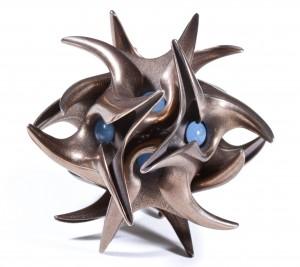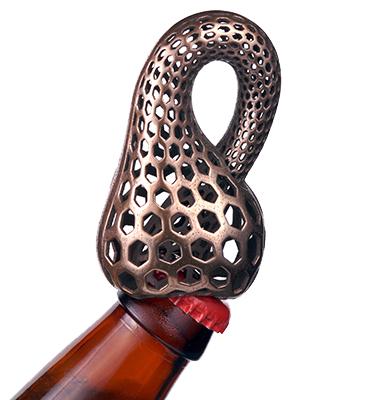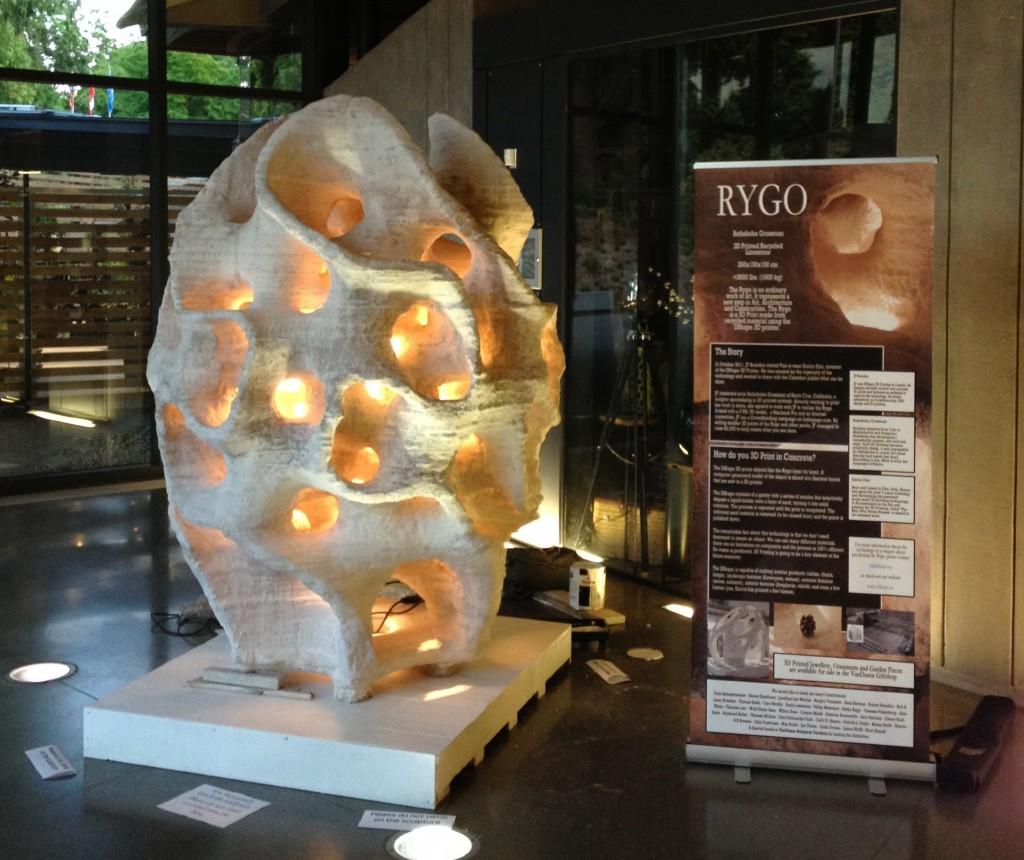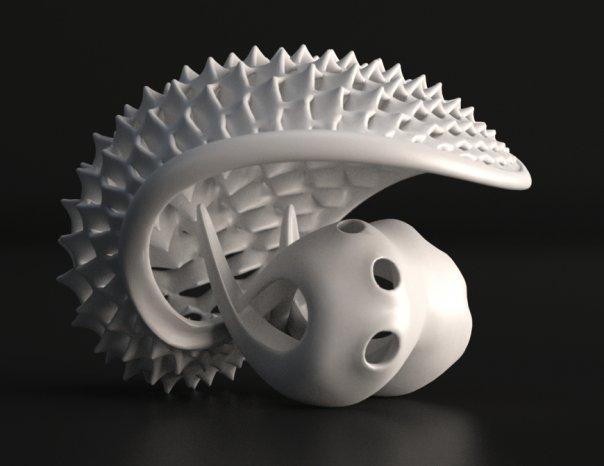Bathsheba Grossman is hailed as a pioneer in 3D printed art, yet she seems to prefer concocting mind-spinning and form-focused designs at her Somerville, Massachusetts home base to basking in the spotlight she’s earned among artist peers and devoted fans of her work. As her career timeline attests to, she is a hard working, veteran artist of 3D printed work. She was the first 3D printing artist to open a shop on Shapeways, and her work has been covered in the New York Times, the London Times, and Der Spiegel. Her “Quin” lamp design was included in Time Magazine‘s “The Design 100,” which acknowledged the 100 most influential designs of 2007. This month her work appears in two 3D printing focused exhibits: East Stroudsburg University’s “5 in 3D” show and Southwestern University’s “What Things May Come” symposium/exhibit. 3DPrint.com was fortunate to ask Grossman some questions about her 3D printed art career, her creative process, and the future of digital sculpture — all answered from her seasoned vantage point.
Grossman summarizes how integral 3D printing is to her career as follows:
Klein Bottle Opener
“For a little background, what’s unusual about me is simply that I’ve been here a long time. Starting in 1997 with bronze castings from ZCorp prints, I was an early adopter with direct-to-consumer sales, and I believe the first to do ‘direct to consumer’ art with steel printing, which was at that time seen as a purely industrial process. So I have some contacts from back when — I was the first shop on Shapeways — and my older designs are among those that established 3DP, and particularly steel, as a sculpture medium.”
Grossman’s aesthetic is quite distinctive; her high-quality designs — be they sculpture, jewelry, housewares, or laser etched glass — are inspired directly or indirectly by mathematic forms. A perusal of her website and Shapeways shop shows how diverse her designs appear on the surface, yet they are unified by her desire to find — in her words — “symmetry and balance, feeling for the tension between pure geometry and natural forms.” And it goes further than that. Unlike today’s overly exuberant techno-enthusiasts who tend to place the cart of 3D printing technology before the horse of their own refined artistry, it seems Grossman was drawn to 3D printing years ago because she needed it to make the shapes she imagined. And this hasn’t changed for her most recent exhibited pieces in the “5 in 3D” show.
“I’m a designer for 3D printing, so it’s very integral to my work!” Grossman says. “My main focus is printing in steel, and all of my pieces in this show are in that medium. They are symmetrical, in some cases outright geometrical, designs that are completely dependent on 3D printing to be manufactured: without it they would be impossible. I also work with subsurface laser damage in glass. These choices weren’t because I love gadgets, but because the shapes I want aren’t moldable, and I want to make a lot of them. This turns out to be remarkably constraining: most art making and manufacturing methods don’t work, or become very expensive, for reproducing un-moldable objects. Thus I became an early adopter of 3D printing.”
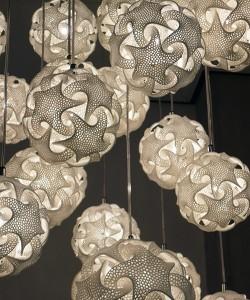
The Quin Lamp
Working largely in steel, Grossman has helped bring the manufacturing and art worlds closer together, while encouraging the development of 3D printing related products. In essence, she has paved the path for other artists to pursue 3D printing in their work — earning her the titles “veteran” and “expert.” On her website, she describes how her history with 3D printing has helped “get better toys”:
“My work inspired other artists to experiment with the technology; meanwhile on the supply side, my sales encouraged machine manufacturers to consider art as a market worth pursuing. As more artists began to work this way, and as Shapeways and other marketing platforms emerged, suppliers have improved their processes and postprocesses — dyes, sealants, patinas, castings — to give a great variety of aesthetically improved prints. This was my plan all along: my purpose in evangelizing was to get better toys, and it’s worked.”
As a veteran artist using 3D printing, Grossman does not herself own a 3D printer because she prefers metal, which requires machines that are not “household or even garage items.” So she outsources the printing to ExOne, the inventors of steel printing, and focuses on perfecting her own use of design software to get the results she seeks.
“For software I use mostly Rhinoceros, with the T-Splines plug-in for organic shapes, and a little ZBrush or Mudbox for texturing,” Grossman tells us. “That Rhino is a surface modeler is integral to what I do: solid modelers such as SolidWorks, and mesh modelers like ZBrush, don’t naturally produce the things I’m looking for.”
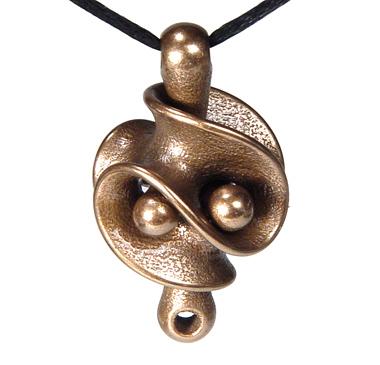
Triple Torus
On her website, Grossman’s sculpture is divided into several categories, including: Classic Designs; Biomorphs; Pure Math; Jewelry; Housewares; and Mini Art. In the “Gallery” section, you can check out her earliest designs under “Early Work.” You can also read an excellent detailed description of her design and printing process. She explains that ExOne prints her steel works and handles most of the post-processing, while she uses Shapeways to print in other materials like silver, bronze, and some plastics. For the time being, Grossman appears to have mastered her design and printing process by maximizing what’s available to create the shapes she wants.
She explains to 3DPrint.com that the hardware side of 3D printing moves more slowly, while the software side is more active:
“On the hardware side the pace of technical change is not actually all that quick. The last major new material to be introduced was ceramics, which was in 2011, and before that the last big jump was steel printing in 2003. There have been incremental improvements in that time, and probably new plastics which I don’t follow closely. As I mentioned, postprocessing has improved greatly, but it’s not like there’s a big jump every six months… The software side is more active, maybe: I’m quite interested to explore the new voxel-based modeling tools such as 3DCoat.”
Versatility is another key feature of Grossman’s artwork. Before you situate her in your mind as a “metals only” type artist, you should know that she is also responsible for designing a 7-foot-tall 3D printed cement sculpture in 2012: Rygo was commissioned by a Vancouver gallery, and is now located at Gropps Gallery, also in Vancouver.
Other commissioned works draw on her dynamic form design, such as her 28-inch-tall sculpture “Flow,” which was commissioned by a private donor and stands at University of Illinois, Champaign-Urbana’s Beckman Institute. She’s even worked with a team in Breckenridge, Colorado to sculpt one of her designs in snow! Her commissioned work also expresses her consistent sense of balance and symmetry in form that defines her signature design style.
Grossman looks forward to incorporating new innovations into her 3D printed art:
“I’m most interested in the development of new direct-printed archival materials. Metals were the first, the steel that I use and also titanium, but we are now seeing food-safe ceramics processes also, which I think is very fun. Glass has been tried but not yet developed in a commercially viable way, so I’m always excited about any research in that area.”
Whatever the future holds for 3D printing, it is certain Bathsheba Grossman will continue to play a crucial role in the 3D printed art scene. After all, she has been one of the scene’s great movers and shakers since its inception.
To see some of Bathsheba Grossman’s dynamic, form-focused sculpture, it is displayed in the “5 in 3D” and “What Things May Come” exhibits this month, and you can also check out her Shapeways shop, her Facebook page, her Twitter feed, and her website.
Let us know your thoughts on Grossman’s works in the Bathsheba Grossman Art forum thread over at 3DPB.com.
Subscribe to Our Email Newsletter
Stay up-to-date on all the latest news from the 3D printing industry and receive information and offers from third party vendors.
You May Also Like
3D Printing Unpeeled: New Arkema Material for HP, Saddle and Macro MEMS
A new Arkema material for MJF is said to reduce costs per part by up to 25% and have an 85% reusability ratio. HP 3D HR PA 12 S has been...
3D Printing News Briefs, January 20, 2024: FDM, LPBF, Underwater 3D Printer, Racing, & More
We’re starting off with a process certification in today’s 3D Printing News Briefs, and then moving on to research about solute trapping, laser powder bed fusion, and then moving on...
3D Printing Webinar and Event Roundup: December 3, 2023
We’ve got plenty of events and webinars coming up for you this week! Quickparts is having a Manufacturing Roadshow, America Makes is holding a Member Town Hall, Stratafest makes two...
Formnext 2023 Day Three: Slam Dunk
I’m high—high on trade show. I’ve met numerous new faces and reconnected with old friends, creating an absolutely wonderful atmosphere. The excitement is palpable over several emerging developments. The high...


